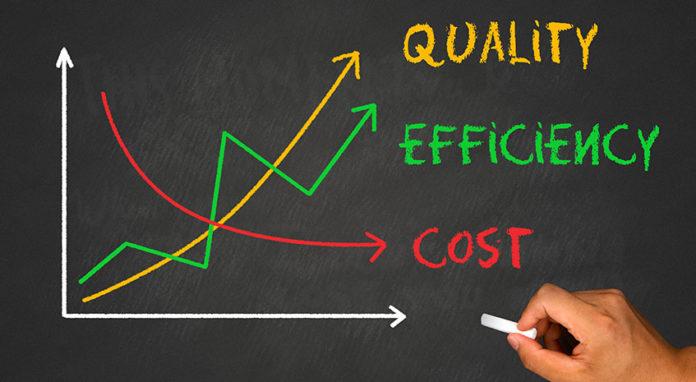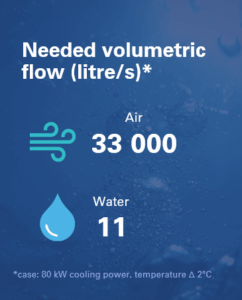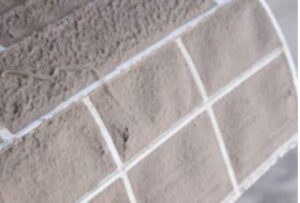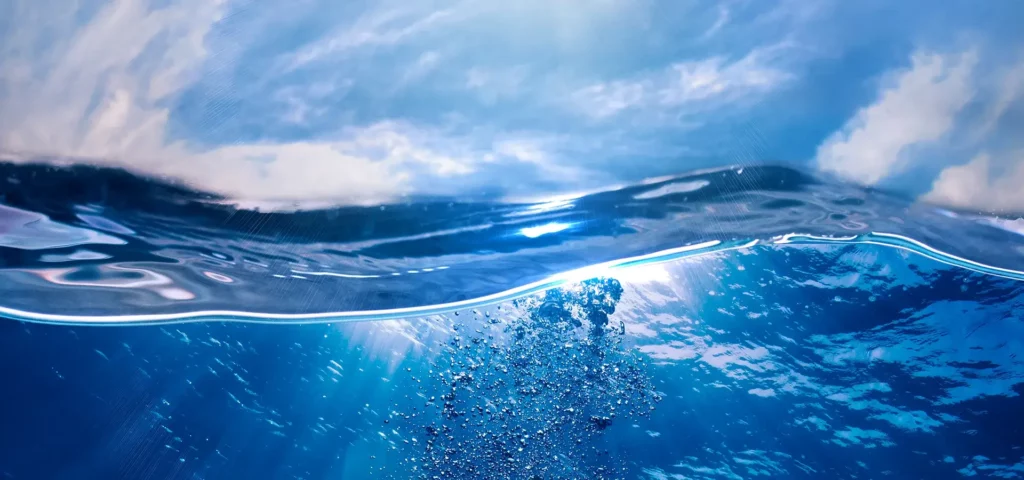Power electronics generate heat. This heat is not good for the electrical components in power electronics system and therefore it needs to be removed from the system. There are practically two principal methods to remove the heat from the system.
Traditionally air has been used to remove the heat. The process principle is simple: air is circulated or blown through the heat generating system. The heat is practically blown away. Air cooling system requires an air circulation system with ducts and vents, a fan unit to move air and a cooler unit to cool down the heated air before it goes back to circulation.
The other alternative to remove the heat is to use water. Here the process is simple as well: the heat source has heat sinks or elements that can be cooled with water. Cold water is circulated to the heat source and heated water is the lead out and cooled with a water-to-water heat exchanger or with a water-to-air cooler. Water cooling system requires a pipesystem, pimpstation and water-to-water heat exhanger or with water-to-air cooler units.
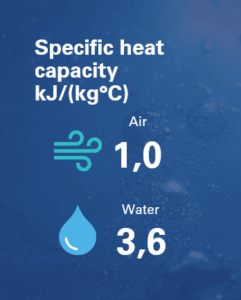
All cooling methods have their positive features and applications. In this article we will focus on the benefits of water cooling.
There are seven features that separate water cooling from other cooling methods:
- Efficiency: water cooling is very energy efficient
- Footprint: water cooling is smaller in size
- Energy saving: water cooling saves energy
- Noise vs. silence: water cooling is silent
- Safety in battery cooling: water cooling is safe
- Harsh condition applications: water cooling is extremely robust
- Installation and maintenance costs: water cooling is number 1
Learn more about Adwatec water cooling solutions
1. Efficiency: water cooling is very energy efficient
Physical properties of water are much better than the properties of air. Actually the specific heat capacity of water is better than that of any other fluid or gas on earth. Water transfers heat more efficiently because of this.
One litre of water can bring about 3000 times more energy out from a system when compared with one litre of air. This comes from the physical properties of air: it’s heat conductivity is poor.
In order to cool well air
- needs to flow fast
- flow has to be turbulent
- surface to interacting with air needs to be large.
All this increases the air resistance, increases the blow pressure and thus power needed. As a result the cooling power of watercooling is superior to air cooling.
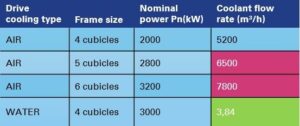
2. Footprint: water cooling is smaller in size
The footprint required by a water cooling system is smaller than required by an air cooling system. This is possible because of the following:
- Water has a better heat capacity than air and therefore enables smaller cooling duct/ element dimensions. As a result water cooled drives can be made more compact.
- Water cooling system is compact as well and normally fits in a standard cabinet. Air cooling system may require a separate air handling room and plenty of air duct lines.
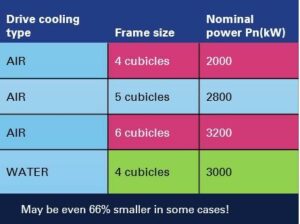
This example from one of the world’s leading drives manufacturers shows the sizing issue:
- An air cooled unit is 50% bigger in size when compared to a water cooled unit, or
- Similar sized air cooled unit is 66% in nominal power of that of a water cooled unit
3. Energy saving: water cooling saves energy
Air cooling requires fans to circulate the air. As the volume of the air needed to cool a system is high, the fans require a lot of electrical energy to perform the cooling.
Water cooling requires pumps to circulate the coolant liquid. As the volume of the liquid needed to cool the system is relatively low, the pumps don’t require the same amount of electrical energy as the fans to perform the cooling.
The difference in the electrical energy consumption is striking big: the water cooling requires less than 10% of the electrical energy of the comparable air cooling system!
This is even more crucial in battery systems where the cooling energy is taken from the battery itself!
4. Noise vs. silence: water cooling is silent
Noise level in air cooled drives systems is considerably higher when compared to water cooled drives systems. The reason for this is the fan motors used in air cooled systems.

5. Safety in battery cooling: water cooling is safe
With any high-power electricity system there is always a safety risk when dealing with water, and there have been concerns about the safety of water cooling in batteries. A water cooling system must therefore be carefully separated from the electrical circuit.
In a theoretical battery fire, high-velocity air releases oxygen into the fire, while the water continues to cool the batteries – preventing them from overheating. Air cooling can’t be used at this stage as it would fuel the fire.
6. Harsh condition applications: water cooling is extremely robust
Water cooling system is a closed system. Dirt or dust will not impact the cooling capacity and availability.
7. Installation and maintenance costs: water cooling is number 1
The high-efficient liquid cooling removes the need for air-conditioning in the installation rooms, bringing the installation and operation costs down. As there is no need for additional air conditioning devices or air ducts, the installation is significantly simplified.
Air cooling systems have built-in filters. These filters have to be cleaned or replaced periodically, depending on the environmental conditions.
A cooling solution shall be selected based a specific application and environment. However, it can be concluded that water cooling has major benefits in many critical applications. The total life cycle cost for a water cooled system with less required foot print, better energy efficiency and lower maintenance effort should attract both system integrators and end users as all sides end up as winners here. Not to forget the legendary reliability coming as a bonus on top of this all!
Learn more about Adwatec water cooling solutions
WORDS: Heikki Mustonen, Managing Director, Adwatec Oy
+358 50 477 8685
heikki.mustonen@adwatec.com
Read more articles
